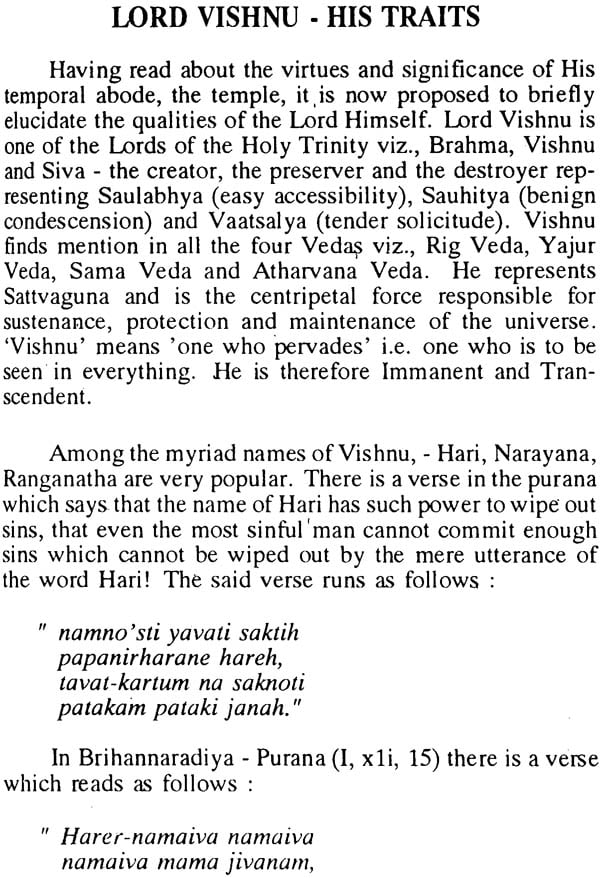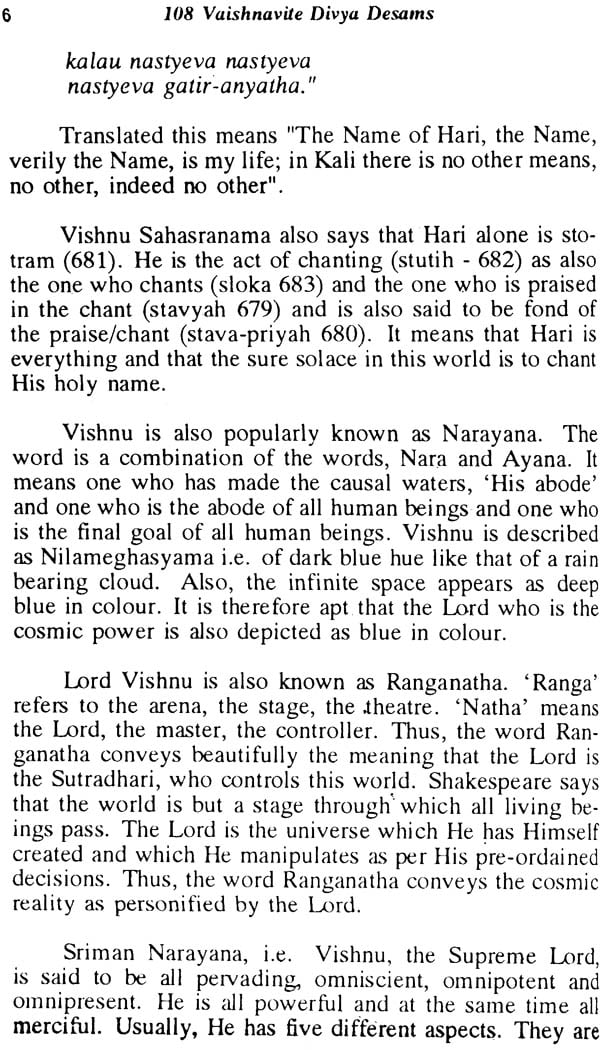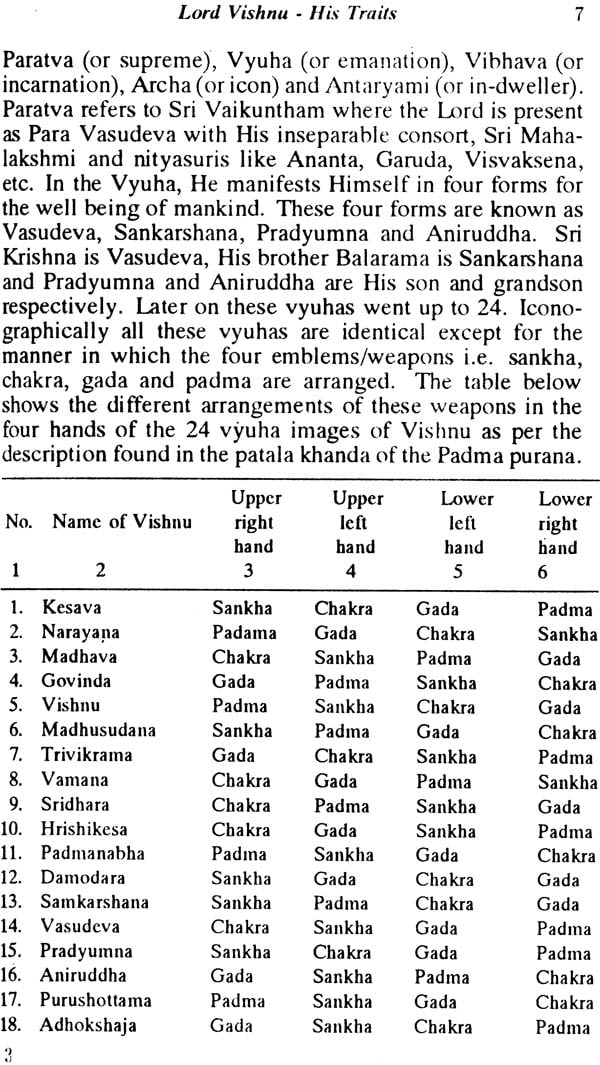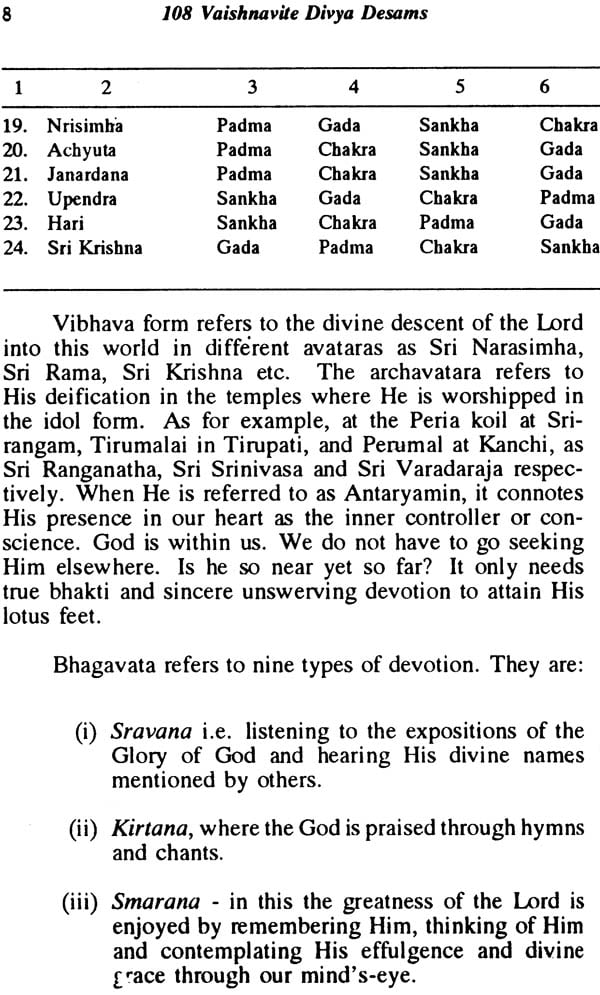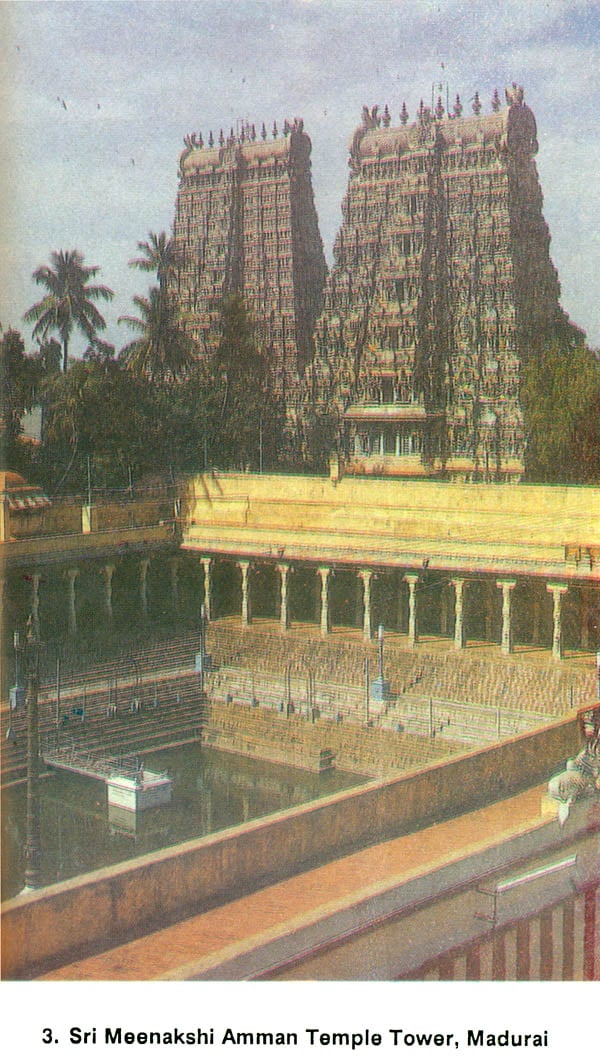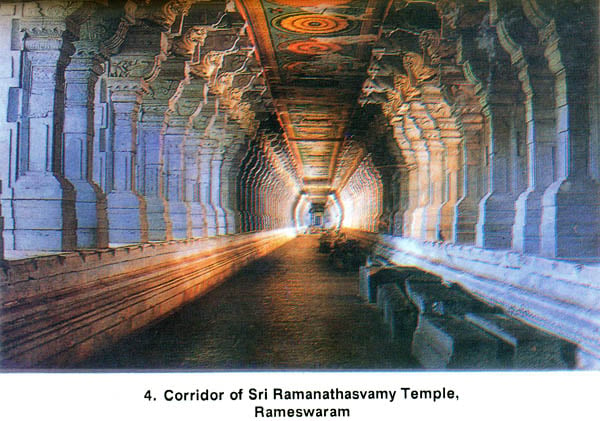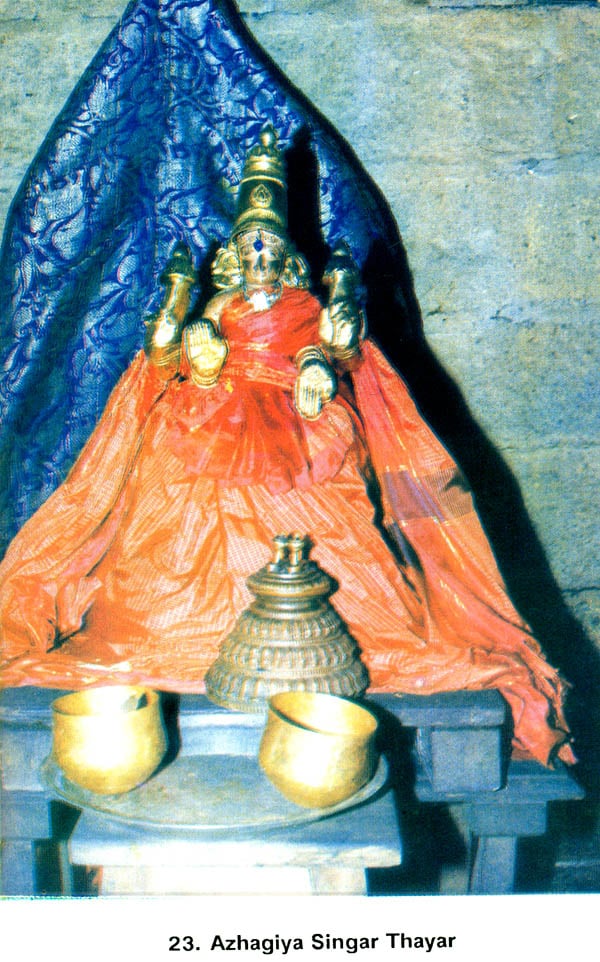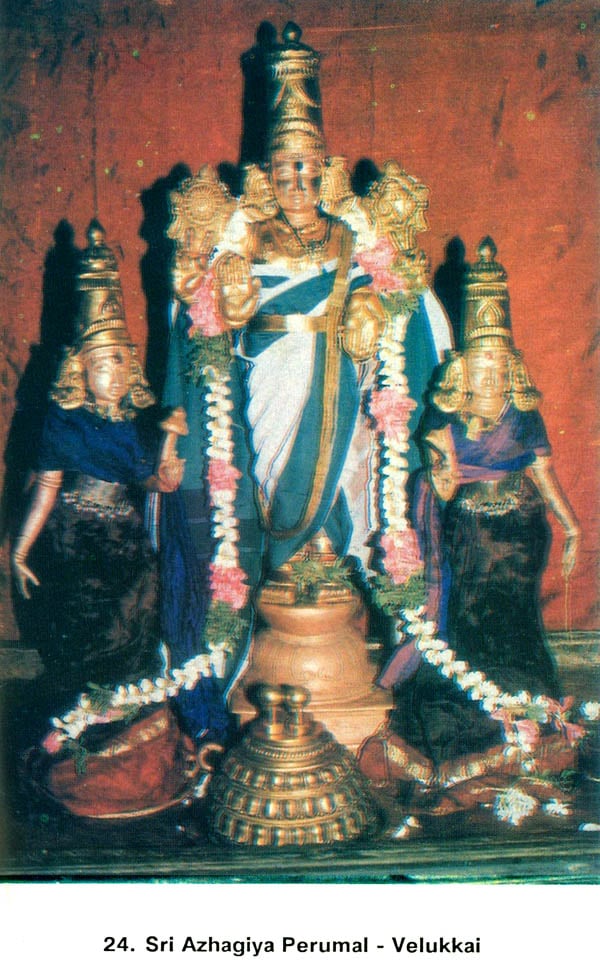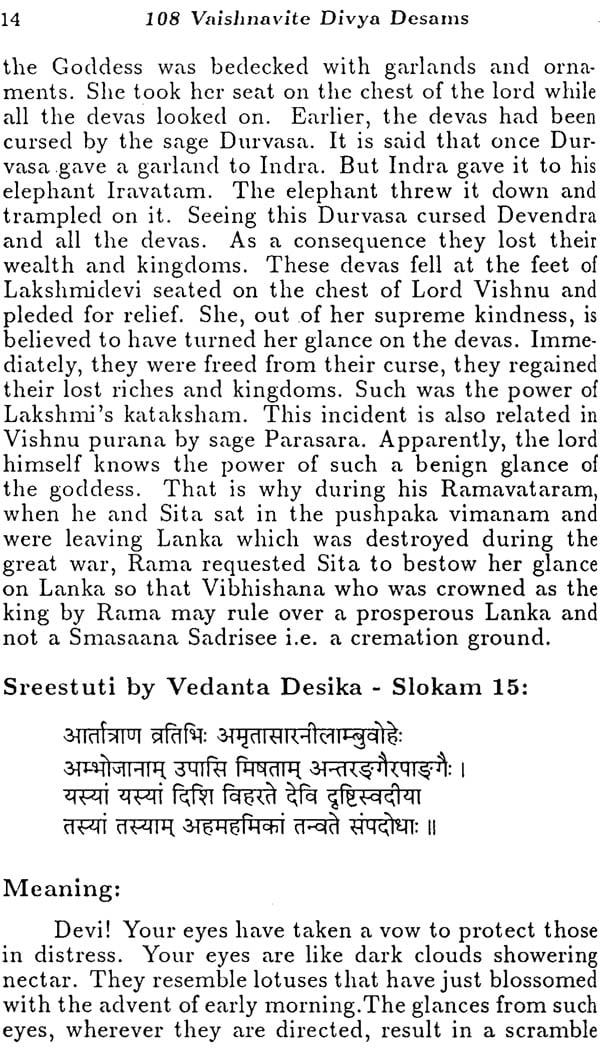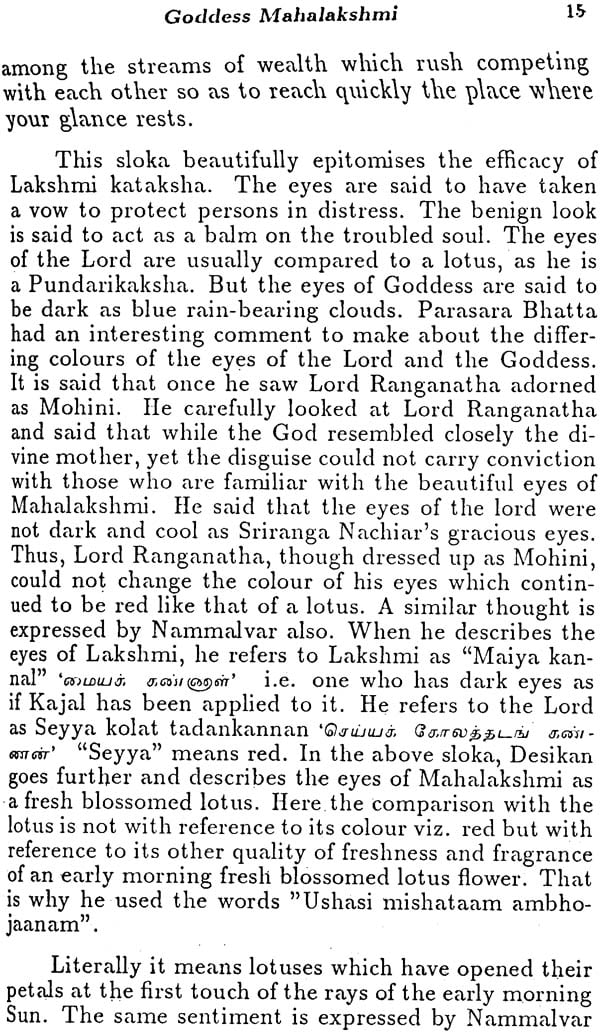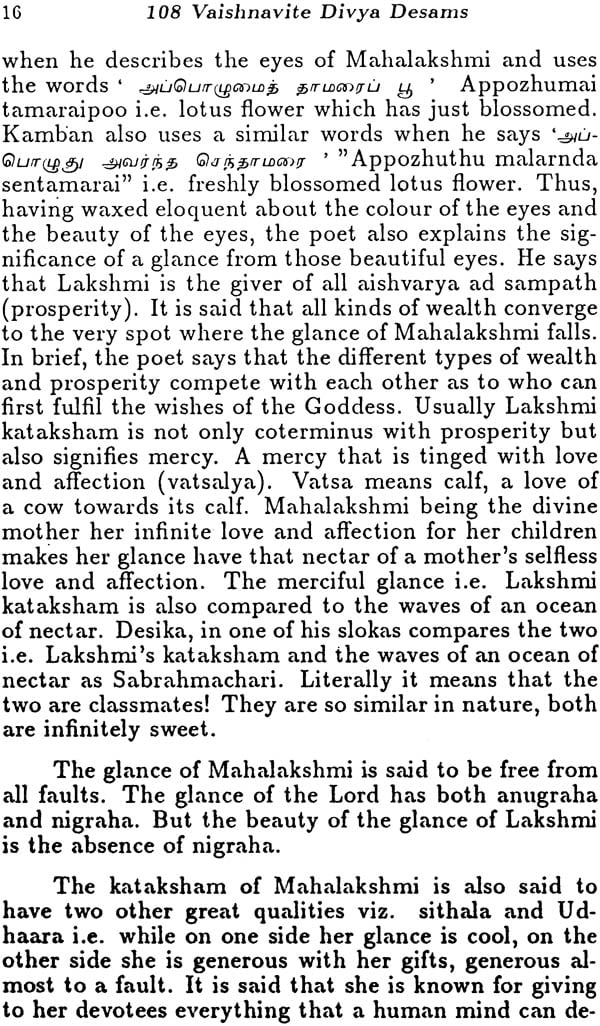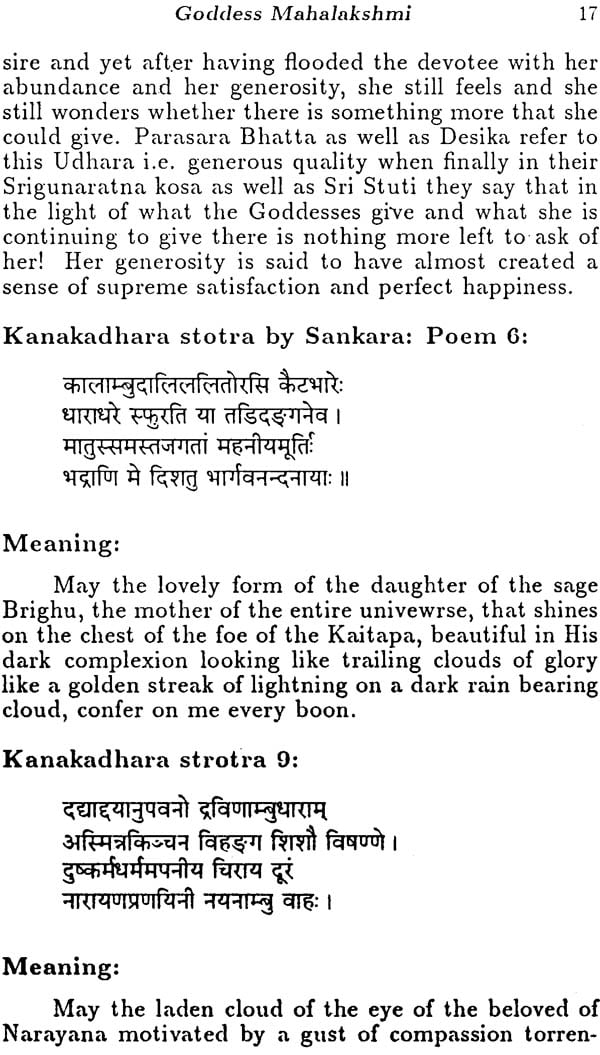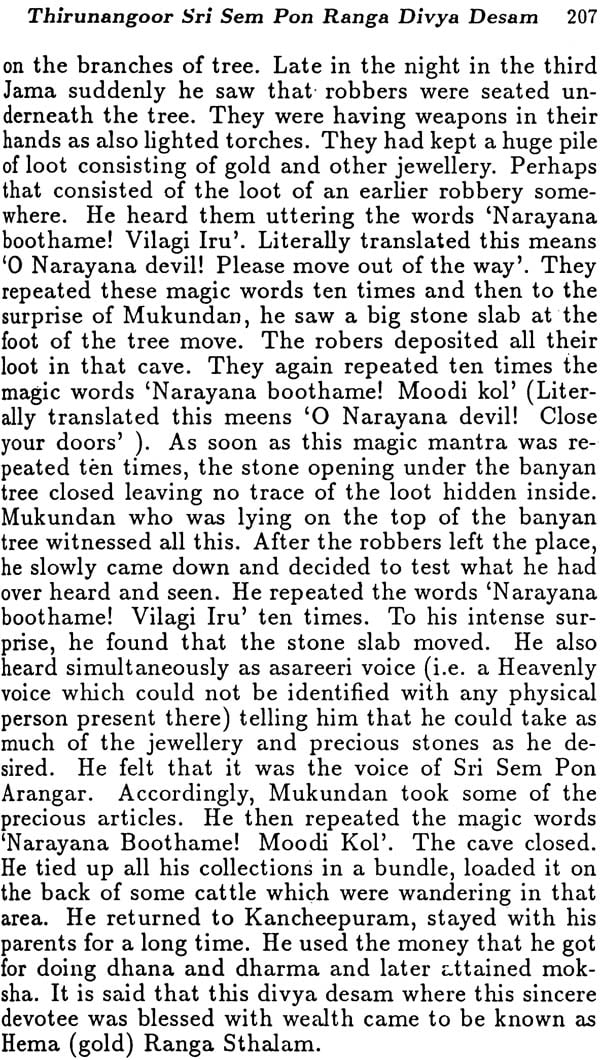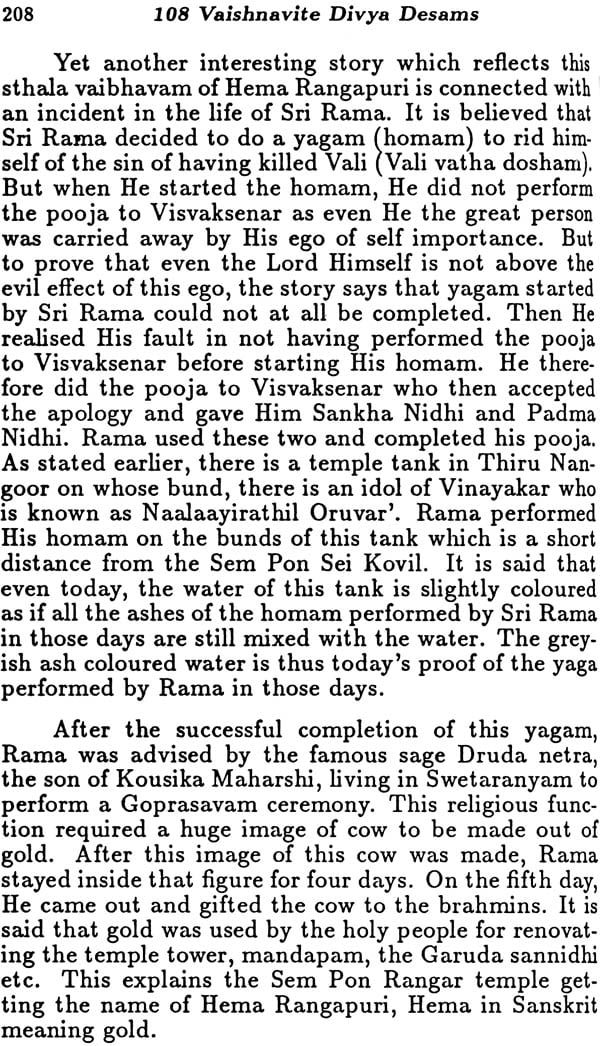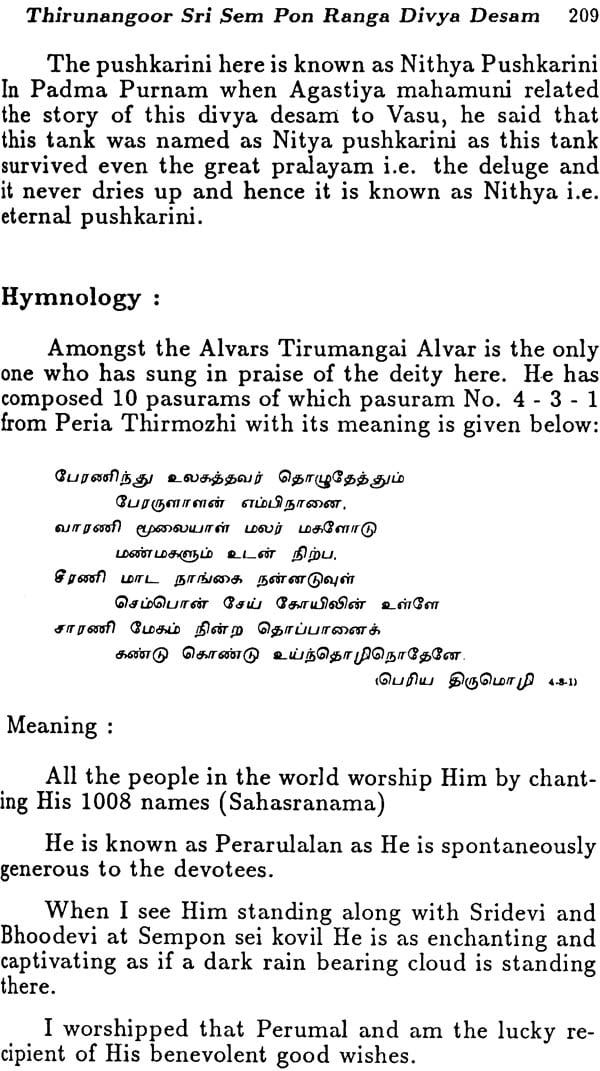
108 Vaishnavite Divya Desams (Set of 7 Volumes) (An Old and Rare Book)
Book Specification
| Item Code: | NAH456 |
| Author: | Miss Dr. M.S. Ramesh |
| Publisher: | Tirumala Tirupati Devasthanams, Tirupati |
| Language: | English & Tamil |
| Edition: | 2016 |
| Pages: | 1863 (With Color Illustrations) |
| Cover: | Paperback |
| Other Details | 8.5 inch x 5.5 inch |
| Weight | 2.30 kg |
Book Description
She is a B.A. (Hons.) and M.Litt., of Madras University. She entered the Indian Administrative Service in 1958.
In the three and half decades in service, she has held various posts from Sub-Collector to Collector, Secretary to Government, in various Departments like Agriculture, Co-Operation, Industries, Social Welfare. She retired as a Principal Commissioner to the Government, in the rank of Chief Secretary. At present she is a Member of the Syndicate of the Madras University. She is also on the Board of Directors of a few companies.
She has authored two other books titled "Tales from Mahabharata" and "Thiruvenkatathu Andhadhi" and "Thiru Venkata Maalai" - an English Translation". She contributes articles to "Sapthagiri" and "Ramanujavani".
The Alwars of Tamil Nadu were supreme devotees of Sriman Narayana. The devotional outpourings of these minstrels of God, called "Nalayira Divya Prabandham" are a living testament of man's immutable faith in the grace and grandeur of the God of gods - Lord Narayana. They testify to the fact that God is everywhere, transcends all that the religions postulate and is realised only through the consciousness.
One of the specific contributions made by the Alwars was to substitute numinous experience to theological speculations. They believed that the various shrines dedicated to God were really abodes in which He dwells not merely as indwelling and directing spirit but also as the visible idol, worshipped there. These holy shrines, celebrated by the Alwars in their hymns, saturated with devotional fervour, are known as divya desas.
In this volume which covers the well known divya desas of Tondai nadu, the author details the history, legends and the mahatmya of the archavatara consecrated there. Relevant passages from the Divya Prabandha are extensively quoted for the edification of the readers.
We have great pleasure to present the second impression of the first volume.
Vaishnavites attach great sentimental and spiritual significance to the 108 Divya kshetrams. It is the pious wish of all devotees of Lord Vishnu to visit these Divya kshetrams atleast once in' their lifetime and enjoy the unalloyed bliss of seeing the presiding deity in these kshetrams through the eyes of the Alwars by reciting the relevant pasurams from the Naalaayira Divya Prabandham.
Initially my interest was only restricted to studying and familiarising myself with the mythological stories associated with each of these divya kshetrams. To my surprise, I found that almost all the literature in this field is available only in Tamil or in Sanskrit. Very little was written in English. I came across only one book written in English. It was the "108 Divya Desams" by R. Gopalan. But this book was written more as a hand book for the tourists and mentions the exact location of these divya kshetrams, nearest rail head and the way to reach the temple etc. The sthala purana is touched upon in a very brief manner. My reaction was to meet this felt need and make available through the English language to a wider reading public the mythological stories connected with these divya desams.
When I started collecting the sthala puranas of these 108 kshetrams, my brother Dr. M.S. Rajajee, I.A.S. suggested that I widen the scope of my study by covering the inscriptions found on the temple walls in these places and thus present the history of those shrines as deduced from the epigraphical evidence. He also suggested that I present one or two pasurams sung in praise of the Lord at each of these divya desams and give a free translation in English of that divine song. Thus, a very simple plan became a fairly wider project viewing each Divyadesam not only from the mythological angle but also from the epigraphical, archaeological and hymnological angles. What is now attempted I hope will turn out to be a better and more meaningful exercise. I would therefore like to place on record my special thanks to my brother as the entire credit for conceiving the project in its present shape goes only to him.
I find that these 108 divya kshetrams can be broadly classified into the following groups based on their geographical location viz.
(i) Divya kshetrams in Thondai Nadu in Tamil Nadu
(ii) Divya kshetrams in Chola Nadu
(iii) Divya kshetrams in Pandya Nadu
(iv) Divya kshetrams in Malai Nadu
(v) Divya kshetrams in Vada Nadu and
(vi) Divya kshetrams in Paraloka.
It is my intention to cover each one of these groups in a separate volume. The present book is the First Volume which deals with the 22 Vaishnavite divya desams in Thondai Nadu which covers Chengalput and Madras Revenue Districts. I do hope that the reading public would find this book a useful addition to the literature on this subject.
I would also like to specially thank a few, atleast of the many, who have helped me in this work. My elder sister Dr. M.S. Lakshmikumari is a very religious person who collects a lot of books on Hindu philosophy. Even in the midst of her heavy duties as a well known Obstetrician and Gynaecologist she finds time to study the basic texts of Vaishnavite philosophy with the help of a Sanskrit teacher. When I started my work, I therefore found that a fairly good collection of works was available with her. I could check a number of my facts with her and her sanskrit teacher. Very often, I found that the going was becoming a bit tough for want of time and also because most of the literature was in Tamil and I wondered whether it was not too presumptous on my part to take on this mighty task, I used to toy with the idea of giving up the entire work. At such times, it was mainly my brother and my Doctor sister who gave me the necessary encouragement to persevere with the task. My younger sister Miss Revathy Briram is a Chartered Accountant by profession. The moment the written material was ready, she helped me with storing it through the word processor and the computer. She took up on herself cheerfully the task of comparing the original with the typed materials and later with the computer outputs, arranging the photos and the chapters, binding the book, etc. My special thanks are therefore to her: for taking this load off my shoulders. My nephew Chiranjeevi R. Venkatakrishna also had a role to play. I was reminded of the story regarding the construction by Lord Rama of a bridge across the Indian Ocean to go to Lanka, to rescue Seetha Devi. The story says that at that time even the little squirel contributed its mighty services for the great task. It is said in Telugu "Udutha, Udutha Bhakthi" meaning to say that the tiny gesture by the tiny animal had a mighty meaning and significance in the gigantic task of building the bridge.
Temples - Structure and Significance
From time immemorial, temples have been the centres of life in the villages. There is an ancient proverb in Tamil which stipulates that no human being should live in a town which does not have 'a temple. The great Tamil Saint Avvaiyar also said 'Othamal Orunalum irukkavendam' meaning that not a day should pass without praising the Lord. Thus, in the Hindu Society for centuries, temple and the worship of the Lord in the temple have been inseparably intertwined with the lives of the people.
The temple has also played a major role in our social life. The thought and the feeling that there is divinity nearby and that God would not silently watch evil deeds and adharma, acted as a powerful source of restraint on people living in that area. Besides, the temple with its vast expanses, peaceful atmosphere and an aura of divinity, purity and spiritualism, its rituals etc. acted as a sheetanchor, a moral support to help people to swim through the ocean of the world. Besides, the construction and maintenance of the temple provided employment to the sculptors, artisans and labourers. Further, the pravachanas and Harikathas conducted in the temple premises helped in educating the members of the society about our glorious heritage. Music, dance and other fine arts also received great encouragement through the temple. With its rich granaries, the temple helped to feed the hungry. The temple very often played the role of a Court of Law for settling disputes, in the presence of God. Thus, the temple virtually had a part to play in the economic, social, cultural and legal life of the people in that area.
Temples are broadly classified into three types:-
The Nagara is distinguished by curvilinear tower the Dravida (Dravida style has its towers in the form of truncated pyramids) and Vesara (an admixture of the above two styles). Generally Dravida types of temples are found in the South and the Nagara types are found in the North. Vesara type of temples are mostly found in Western Deccan and South.
Temples do not seem to have existed during the Vedic age. The practice of carving out the images of the deities mentioned in the Vedas seems to have come into vogue by the end of the Vedic period. The earliest temples were built with perishable materials like timber and clay. Later, they were carved out of stones. Heavy stone structures with detailed architectural style and fine sculptures are a more recent phenomenon.
Considering the vast size of the country, it is amazing that the construction of the temple is more or less on the same pattern everywhere. This is because the temple and its construction reflects certain basic and significant aspects of Hindu Philosophy as detailed below.
The temple is the house of God on earth. Thus, it provides a link between man and God. The Rajagopuram is the main gateway to this terrestrial house of God The dhvajastambha in a, temple represents a flag post on which is flown the flag of the main deity of the temple Outer walls i.e. prakaras are the walls of the house. The Garbhagriha is the sanctum sanctorum wherein the main deity is. housed. The tower on the top of the garbhagriha is the vimana. Usually, the temple is compared to a human body. Tirumular the Saivite saint said "our body is temple". Kathopanishad says "the body of ours is a temple of the Divine". The parts of the body are compared with the different parts of the temple. The vimana is the head The sanctum sanctorum is the neck, the front mandapa the stomach, the prakara walls are legs, the gopura is the feet and the Lord in the sanctum is the Jeeva of the body.
The 108 divya desas are the most sanctified places of worship in our country. These pilgrim centres rapturously praised in the hymns of the great Alwars are not only very ancient but also the formidable citadels of piety. The forms of Sriman Narayana as consecrated in these holy shrines have a special place in the heart of every devotee.
Though Maha Vishnu assumes various aspects such as Para, Vyuha, Vibhava, Antaryami and Arca, it is in the worship of His iconic form the Alwars found immeasurable joy and ecstasy. They realized that the Lord is the very acme of simplicity reaching out to reclaim the fallen souls. These mystic bards, soaked in divine love, visited the divya desas, admired the towers and turrets there and described the grandeur and glory of the Deities enshrined there in exquisite poetry.
Among these divya desas, the temples in the Chola nadu are invested with great antiquity. These hallowed places where Lord Narayana revealed Himself in various auspicious forms to uphold Dharma are notable for their sculptural and architectural wealth. Myths, legends and history blend together to give these sthalas a unique place among the sacred temples of this great land.
The present book is the second of the series in the 108 Vaishnavite divya desams. The first volume dealing with 22 Vaishnavite shrines in Tondai nadu (consisting of old Chengalpet and Madras revenue districts) was well received by the discerning public. In this work Miss. M.S. Ramesh, who had a distinguished career as a senior civil servant, traces the origin and antiquity of a score of temples. She has also incorporated relevant passages from the Divya Prabandha to establish their relative superiority.
We invite our readers to share in the supreme bliss of rediscovering our spiritual heritage as embodied in these divya desas.
It is with utmost pleasure we present the second reprint of this volume.
In Volume I of this series on the 108 Vaishnavite Divya Desams, I had dealt with 22 Vaishnavite Divya Desams in Thondai Nadu covering old Chengelpet and Madras Revenue Districts in Tamil Nadu. There are 42 Divya Desams in Chola Nadu. To cover the entire lot in one volume will make it too bulky and inconvenient for handling. To facilitate easy reading, it is proposed to deal with it in two volumes. This volume, therefore, deals with only 21 of the 42 Divya Desams in Chola Nadu. The manner of presentation of the material is the same as was followed earlier in Volume I viz. the Mythology, Hymnology, Archaeological and Epigraphical highlights of each Divya Desam is presented in a brief manner. Surprisingly there are not many epigraphical materials in these temples in the Divya Desams of Chola Nadu. But these temples make up for the absence of epigraphical materials by their sculptural and artistic excellence.
My task in presenting the material in this book has been affectionately shared by many. I will be failing in my duty if I do not place on record my deep debt of gratitude to them. First and foremost I most sincerely thank my family members who not only encouraged me in this work but also lent all support by going through my drafts, collecting material, photos, arranging for binding etc. But for their continued moral and physical support I would have found the work too exacting.
I also owe a deep debt of gratitude to many of my friends and colleagues who have extended to me their unstinting cooperation in collecting the material from the respective devasthanams, old residents of those places. They collected both published and unpublished material relating to each of these Divya Desams. Special mention in this regard should be made of my colleagues viz. Thiru R.Chandrakanthan, Thiru Ramanujam and Thiru K.Bhakthavatsalam, who have taken a lot of trouble in collecting not only the material but also taking the trouble of personally taking photographs of the various temple towers and collecting photographs of the various utsavars so as to make the book more interesting and illustrative. I can only pray to God to bless them for the affectionate sincere manner in which they helped me in this task. Tvl. K.Ramji and N.Muthukrishnan have again proved their mettle as efficient stenographers by willingly and cheerfully typing out all the material that I dictate to them. The secretarial assistance extended by them was so excellent that it made my task easy. I would be failing in my duty if I do not publicly acknowledge my continued thanks to Mr.V.N.Srinivasan who willingly took on the task of writing the pasurams in Tamil in the Hymnology sections. Shri. Sthala Sayana Thuraivar Avl. continued to extend to me his scholarly assistance in selecting specific mangalasasana pasurams for each divya kshetram and explaining to me its meaning. My special thanks are also to him. Mr.M.N.Krishnaswamy the Publisher of Ramanujavani also was of immense strength to me, as, whenever I had any doubts or needed clarifications, he was only too willing to help me with pleasure. My special thanks are also to Dr. R. Ananthan, Professor and Head of the Department of English, Vivekananda College, Madras, who read through all my manuscripts with a professorial discipline so as to ensure that good grammatical English is used.
I hope that with grace of Lord Venkatachalapathy the balance of work relating to 65 Divya Desams will also be completed at an early date.
| Introduction | 1 |
| Lord Vishnu - His traits | 5 |
| Sri Parthasarathy Swami Temple | 17 |
| Sri Varadaraja Swami Temple | 33 |
| Sri Pandavadootha Perumal Temple | 57 |
| Sri Deepa Prakasa Temple | 61 |
| Sri Yadothkari Temple | 66 |
| Sri Ashtabhuja Perumal Temple | 73 |
| Sri Azagia Singar Temple | 79 |
| Sri Nilathingalthundathan | 82 |
| Sri Pavalavannar Temple | 86 |
| Sri Vaikuntaperumal Temple | 90 |
| Sri Adivaraha Perumal Temple | 95 |
| Sri Ulagalanda Perumal Temple | 98 |
| Sri Vijayaraghava Perumal Temple | 109 |
| Sri Yoga Neeragathan Shrine | 115 |
| Sri Bhakthavatsala Perumal Temple | 123 |
| Sri Veeraraghava Peru mal Temple | 129 |
| Sri Ranganathaswami Perumal Temple | 139 |
| Sri Nithya Kalyana Perumal Temple | 147 |
| Sri Sthalasayana Perumal Temple | 155 |
| Select Bibilography | 165 |
| 1 | Preface | |
| 2 | Introduction - Goddess Maha Lakshmi | 1 |
| 3 | Thiru Srirangam | 20 |
| 4 | Thiru Kannapuram | 65 |
| 5 | Thiru Kannangudi | 102 |
| 6 | Thirukudanthai | 112 |
| 7 | Thiru Sirupuliyur | 151 |
| 8 | Thirunangoor Eleven Garuda Sevai | 159 |
| 9 | Thiru Manimada Kovil | 174 |
| 10 | Thiru Arimeya Vinnagaram | 180 |
| 11 | Thiru Vellakulam | 185 |
| 12 | Thiru Kavalampadi | 190 |
| 13 | Thiru Tetriambalam | 193 |
| 14 | Thiru Vanpurushothaman | 197 |
| 15 | Thiru Vaikunta Vinnagaram | 201 |
| 16 | Thiru Sempon Sei Nangoor | 205 |
| 17 | Thiru Mani Koodam | 211 |
| 18 | Thiru Parthanpalli | 214 |
| 19 | Thiru Devanar Thogai | 218 |
| 20 | Thiru Kazhi Seerama Vinnagaram | 220 |
| 21 | Thiru Vali Thirunagari | 225 |
| 22 | Thiru Indalur | 239 |
| 23 | Thiru Kandiyur | 248 |
| 24 | Bibliography | 257 |
